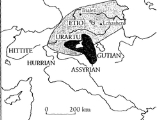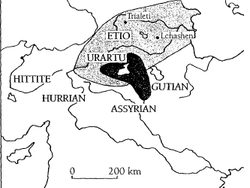
Prehistoric Armenia
Encyclopedia
The Armenian Highland
shows traces of settlement from the Neolithic
era. The Shulaveri-Shomu culture
of the central Transcaucasus
region is one of the earliest known prehistoric culture in the area, carbon-dated to roughly 6000 - 4000 BC. Another early culture in the area is the Kura-Araxes culture
, assigned to the period of ca. 4000 - 2200 BC, succeeded by the Trialeti culture
(ca. 2200 - 1500 BC).
incursions into Armenia
was to obtain metals. The iron-working age followed that of bronze everywhere, opening a new epoch of human progress. Its influence is noticeable in Armenia, and the transition period is well marked. Tombs whose metal contents are all of bronze are of an older epoch. In most of the cemeteries explored, both bronze and iron furniture were found, indicating the gradual advance into the Iron Age.

Armenian Highland
The Armenian Highland is the central-most and highest of three land-locked plateaus that together form the northern sector of the Middle East...
shows traces of settlement from the Neolithic
Neolithic
The Neolithic Age, Era, or Period, or New Stone Age, was a period in the development of human technology, beginning about 9500 BC in some parts of the Middle East, and later in other parts of the world. It is traditionally considered as the last part of the Stone Age...
era. The Shulaveri-Shomu culture
Shulaveri-Shomu culture
Shulaveri-Shomu culture is a Late Neolithic/Eneolithic culture that existed on the territory of present-day Georgia and the Armenian Highlands. It is thought to be a critical element in identifying the origins of both the Georgian and Armenian peoples. The culture is dated to mid-6th or early-5th...
of the central Transcaucasus
South Caucasus
The South Caucasus is a geopolitical region located on the border of Eastern Europe and Southwest Asia also referred to as Transcaucasia, or The Trans-Caucasus...
region is one of the earliest known prehistoric culture in the area, carbon-dated to roughly 6000 - 4000 BC. Another early culture in the area is the Kura-Araxes culture
Kura-Araxes culture
The Kura-Araxes culture or the Early trans-Caucasian culture, was a civilization that existed from 3400 BC until about 2000 BC. The earliest evidence for this culture is found on the Ararat plain; thence it spread to Georgia by 3000 BC, and during the next millennium it proceeded westward to the...
, assigned to the period of ca. 4000 - 2200 BC, succeeded by the Trialeti culture
Trialeti culture
The Trialeti culture , named after Trialeti region of Georgia, is attributed to the first part of the 2nd millennium BC. In the late 3rd millennium BC. settlements of the Kura-Araxes culture began to be replaced by early Trialeti culture sites. The Trialeti culture was a second culture to appear in...
(ca. 2200 - 1500 BC).
Excavation campaigns
Revue archeologique issued a report by M. de Morgan, on his excavations, and says:Bronze Age
The main object of early AssyrianAssyria
Assyria was a Semitic Akkadian kingdom, extant as a nation state from the mid–23rd century BC to 608 BC centred on the Upper Tigris river, in northern Mesopotamia , that came to rule regional empires a number of times through history. It was named for its original capital, the ancient city of Assur...
incursions into Armenia
Armenian Highland
The Armenian Highland is the central-most and highest of three land-locked plateaus that together form the northern sector of the Middle East...
was to obtain metals. The iron-working age followed that of bronze everywhere, opening a new epoch of human progress. Its influence is noticeable in Armenia, and the transition period is well marked. Tombs whose metal contents are all of bronze are of an older epoch. In most of the cemeteries explored, both bronze and iron furniture were found, indicating the gradual advance into the Iron Age.
Iron Age

See also
- Mount AraratMount AraratMount Ararat is a snow-capped, dormant volcanic cone in Turkey. It has two peaks: Greater Ararat and Lesser Ararat .The Ararat massif is about in diameter...
- Armenian hypothesisArmenian hypothesisThe Armenian hypothesis of the Proto-Indo-European Urheimat, based on the Glottalic theory suggests that the Proto-Indo-European language was spoken during the 4th millennium BC in the Armenian Highland or Aryan Highland. It is an Indo-Hittite model and does not include the Anatolian languages in...
- KarahunjZorats KarerZorats Karer , also called Karahunj, Carahunge or the Armenian Stonehenge) is an archaeological site near the city of Sisian in the Syunik province of Armenia.-Description:...
- Hayk
- Hayasa-AzziHayasa-AzziHayasa-Azzi or Azzi-Hayasa was a Late Bronze Age confederation formed between two petty kingdoms of Anatolia, Hayasa located South of Trabzon and Azzi, located North of the Euphrates and to the South of Hayasa...
- Nairi (people)Nairi (people)Nairi was the Assyrian name for an Armenian tribe in the Armenian Highlands, roughly corresponding to the modern Van and Hakkâri provinces of modern Turkey...
- Prehistoric GeorgiaPrehistoric GeorgiaThe prehistory of Georgia is the period between the first human habitation of the territory of modern-day nation of Georgia and the time when Assyrian and Urartian, and more firmly, the Classical accounts, brought the proto-Georgian tribes into the scope of recorded history.-Paleolithic:Humans have...

